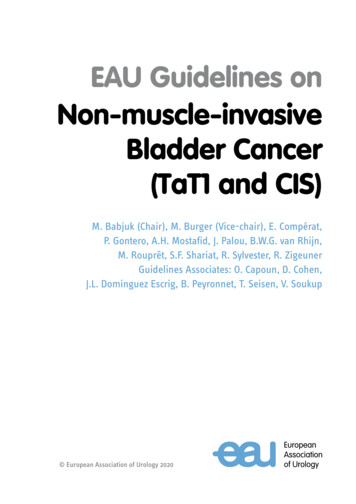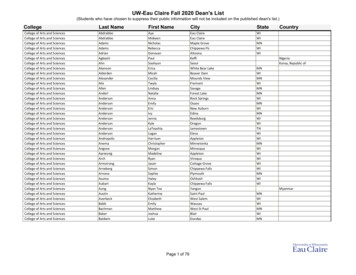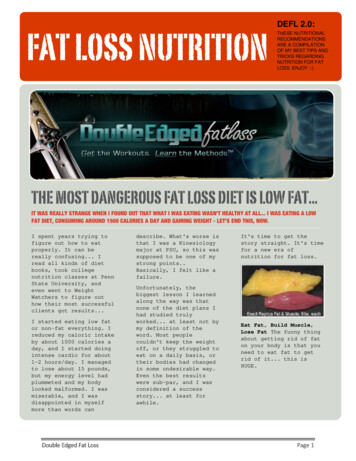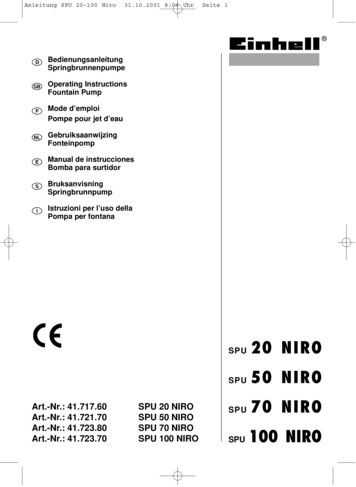
Transcription
EAU Guidelines onNon-muscle-invasiveBladder Cancer(TaT1 and CIS)M. Babjuk (Chair), M. Burger (Vice-chair), E. Compérat,P. Gontero, A.H. Mostafid, J. Palou, B.W.G. van Rhijn,M. Rouprêt, S.F. Shariat, R. Sylvester, R. ZigeunerGuidelines Associates: O. Capoun, D. Cohen,J.L. Dominguez Escrig, B. Peyronnet, T. Seisen, V. Soukup European Association of Urology 2020
TABLE OF CONTENTS1.PAGEINTRODUCTION1.1Aim and scope1.2Panel composition1.3Available publications1.4Publication history and summary of changes1.4.1Publication history1.4.2Summary of changes55555552.METHODS2.1Data Identification2.2Review2.3Future goals66773.EPIDEMIOLOGY, AETIOLOGY AND 4Summary of evidence for epidemiology, aetiology and pathology777884.STAGING AND CLASSIFICATION SYSTEMS4.1Definition of non-muscle-invasive bladder cancer4.2Tumour, Node, Metastasis Classification (TNM)4.3T1 subclassification4.4Histological grading of non-muscle-invasive bladder urothelial carcinomas4.5Carcinoma in situ and its classification4.6Inter- and intra-observer variability in staging and grading4.7Variants of urothelial carcinoma and lymphovascular invasion4.8Molecular classification4.9Summary of evidence and guidelines for bladder cancer classification5.DIAGNOSIS5.1Patient history5.2Signs and symptoms5.3Physical examination5.4Imaging5.4.1Computed tomography urography and intravenous urography5.4.2Ultrasound5.4.3Multiparametric magnetic resonance imaging5.5Urinary cytology5.6Urinary molecular marker tests5.7Potential application of urinary cytology and markers5.7.1Screening of the population at risk of bladder cancer5.7.2Exploration of patients after haematuria or other symptoms suggestiveof bladder cancer (primary detection)5.7.3Surveillance of non-muscle-invasive bladder cancer5.7.3.1Follow-up of high-risk non-muscle-invasive bladder cancer5.7.3.2Follow-up of low/intermediate-risk non-muscle-invasivebladder cancer5.8Cystoscopy5.9Summary of evidence and guidelines for the primary assessment ofnon-muscle-invasive bladder cancer5.10 Transurethral resection of TaT1 bladder tumours5.10.1 Strategy of the procedure5.10.2 Surgical and technical aspects of tumour resection5.10.2.1 Surgical strategy of resection (piecemeal/separate resection,en-bloc resection)5.10.2.2 Evaluation of resection quality5.10.2.3 Monopolar and bipolar 31313131314141414141415NON-MUSCLE-INVASIVE BLADDER CANCER (TAT1 AND CIS) - LIMITED UPDATE MARCH 2020
5.10.2.4 Office-based fulguration and laser vaporisation5.10.2.5 Resection of small papillary bladder tumours at the timeof transurethral resection of the prostate5.10.3 Bladder biopsies5.10.4 Prostatic urethral biopsies5.11 New methods of tumour visualisation5.11.1 Photodynamic diagnosis (fluorescence cystoscopy)5.11.2 Narrow-band imaging5.11.3 Additional technologies5.12 Second resection5.12.1 Detection of residual disease and tumour upstaging5.12.2 The impact of second resection on treatment outcomes5.12.3 Timing of second resection5.12.4 Recording of results5.13 Pathology report5.14 Summary of evidence and guidelines for transurethral resection of the bladder,biopsies and pathology report6.151515151515161616161616161617PREDICTING DISEASE RECURRENCE AND PROGRESSION6.1TaT1 tumours6.2Carcinoma in situ6.3Patient stratification into risk groups6.4Subgroup of highest-risk tumours6.5Summary of evidence and guidelines for stratification of non-muscle-invasivebladder cancer18182020207.21212121DISEASE MANAGEMENT7.1Counselling of smoking cessation7.2Adjuvant treatment7.2.1Intravesical chemotherapy7.2.1.1A single, immediate, post-operative intravesical instillationof chemotherapy7.2.1.2Additional adjuvant intravesical chemotherapy instillations7.2.1.3Options for improving efficacy of intravesical chemotherapy7.2.1.3.1Adjustment of pH, duration of instillation, and drugconcentration7.2.1.3.2Device-assisted intravesical chemotherapy7.2.1.4Summary of evidence - intravesical chemotherapy7.2.2Intravesical bacillus Calmette-Guérin (BCG) immunotherapy7.2.2.1Efficacy of BCG7.2.2.2BCG strain7.2.2.3BCG toxicity7.2.2.4Optimal BCG schedule7.2.2.5Optimal dose of BCG7.2.2.6Indications for BCG7.2.2.7Summary of evidence - BCG treatment7.2.3Combination therapy7.2.3.1Intravesical BCG chemotherapy versus BCG alone7.2.3.2Combination treatment using interferon7.2.4Specific aspects of treatment of carcinoma in situ7.2.4.1Treatment strategy7.2.4.2Cohort studies on intravesical BCG or chemotherapy7.2.4.3Prospective randomised trials on intravesical BCG or chemotherapy7.2.4.4Treatment of CIS in prostatic urethra and upper urinary tract7.2.4.5Summary of evidence - treatment of carcinoma in situ7.3Treatment of failure of intravesical therapy7.3.1Failure of intravesical chemotherapy7.3.2Recurrence and failure after intravesical BCG immunotherapy7.3.3Treatment of BCG failure7.3.4Summary of evidence - treatment failure of intravesical therapyNON-MUSCLE-INVASIVE BLADDER CANCER (TAT1 AND CIS) - LIMITED UPDATE MARCH 2729292929303
7.47.57.67.7Radical cystectomy for non-muscle-invasive bladder cancerGuidelines for adjuvant therapy in TaT1 tumours and for therapy of carcinoma in situTreatment recommendations in TaT1 tumours and carcinoma in situ according torisk stratificationGuidelines for the treatment of BCG failure8.31323333FOLLOW-UP OF PATIENTS WITH NMIBC8.1Summary of evidence and guidelines for follow-up of patients after transurethralresection of the bladder for non-muscle-invasive bladder cancer349.REFERENCES3510.CONFLICT OF INTEREST5311.CITATION INFORMATION54434NON-MUSCLE-INVASIVE BLADDER CANCER (TAT1 AND CIS) - LIMITED UPDATE MARCH 2020
1.INTRODUCTION1.1Aim and scopeThis overview represents the updated European Association of Urology (EAU) Guidelines for Non-muscleinvasive Bladder Cancer (NMIBC), TaT1 and carcinoma in situ (CIS). The information presented is limited tourothelial carcinoma, unless specified otherwise. The aim is to provide practical recommendations on theclinical management of NMIBC with a focus on clinical presentation and recommendations.Separate EAU Guidelines documents are available addressing upper tract urothelial carcinoma(UTUC) [1], muscle-invasive and metastatic bladder cancer (MIBC) [2] and primary urethral carcinoma [3]. Itmust be emphasised that clinical guidelines present the best evidence available to the experts, but followingguideline recommendations will not necessarily result in the best outcome. Guidelines can never replaceclinical expertise when making treatment decisions for individual patients, but rather help to focus decisions also taking personal values and preferences/individual circumstances of patients into account. Guidelines arenot mandates and do not purport to be a legal standard of care.1.2Panel compositionThe EAU Guidelines Panel on NMIBC consists of an international multidisciplinary group of clinicians,including urologists, uro-oncologists, a pathologist and a statistician. Members of this Panel havebeen selected based on their expertise and to represent the professionals treating patients suspectedof suffering from bladder cancer. All experts involved in the production of this document havesubmitted potential conflict of interest statements which can be viewed on the EAU website ive-bladder-cancer/.1.3Available publicationsA quick reference document (Pocket guidelines) is available, both in print and as an app for iOS and Androiddevices. These are abridged versions which may require consultation together with the full text version. Severalscientific publications are available, the latest publication dating to 2019 [4], as are a number of translations ofall versions of the EAU NMIBC Guidelines. All documents are accessible through the EAU website asive-bladder-cancer/.1.4Publication history and summary of changes1.4.1Publication historyThe EAU Guidelines on Bladder Cancer were first published in 2000. This 2020 NMIBC Guidelines documentpresents a limited update of the 2019 publication.1.4.2Summary of changesAdditional data has been included throughout this document text. In particular in sections: 4.7 - Variants of urothelial carcinoma and lymphovascular invasion: this section has been expanded toinclude further information on variant histologies.7.3 - Treatment of failure of intravesical therapy. This section has been considerably expanded, alongsidea revision of Figure 7.2, Table 7.2 (Categories of unsuccessful treatment with intravesical BCG) and 7.7Guidelines for the treatment of BCG failure.Recommendations have been changed in sections:7.5 Guidelines for adjuvant therapy in TaT1 tumours and for therapy of carcinoma in situGeneral recommendationsOffer a RC to patients with BCG unresponsive tumours (see Section 7.7).Strength ratingStrongOffer patients with BCG unresponsive tumours, who are not candidates for RC due toWeakcomorbidities, preservation strategies (intravesical chemotherapy, chemotherapy andmicrowave-induced hyperthermia, electromotive administration of chemotherapy, intravesialor systemic immunotherapy; preferably within clinical trials).NON-MUSCLE-INVASIVE BLADDER CANCER (TAT1 AND CIS) - LIMITED UPDATE MARCH 20205
7.7 Guidelines for the treatment of BCG failureCategoryTreatment optionsBCG-unresponsive1. Radical cystectomy (RC)StrengthratingStrong2. Enrollment in clinical trials assessing new treatment strategies.Weak3. Bladder-preserving strategies in patients unsuitable or refusing RC. WeakLate BCG relapsing:T1Ta/HG recurrence1. Radical cystectomy or repeat BCG course according to individualsituation.2. Bladder-preserving strategies 6 months or CIS 12 months of last BCGexposureLG recurrence after BCG 1. Repeat BCG or intravesical chemotherapyfor primary2. Radical cystectomy2.METHODS2.1Data IdentificationStrongWeakWeakWeakFor the 2019 NMIBC Guidelines, new and relevant evidence has been identified, collated and appraisedthrough a structured assessment of the literature.A broad and comprehensive scoping exercise covering all areas of the NMIBC Guidelines wasperformed. Excluded from the search were basic research studies, case series, reports and editorial comments.Only articles published in the English language, addressing adults, were included. The search was restrictedto articles published between June 8th 2018 and May 16th, 2019. Databases covered by the search includedPubmed, Ovid, EMBASE and the Cochrane Central Register of Controlled Trials and the Cochrane Databaseof Systematic Reviews. After deduplication, a total of 1,124 unique records were identified, retrieved andscreened for relevance.A total of 29 new publications were added to the 2020 NMIBC Guidelines. A detailedsearch strategy is available online: laddercancer/?type appendices-publications.For Chapters 3-6 (Epidemiology, Aetiology and Pathology, Staging and Classification systems, Diagnosis,Predicting disease recurrence and progression) references used in this text were assessed according totheir level of evidence (LE) based on the 2009 Oxford Centre for Evidence-Based Medicine (CEBM) Levels ofEvidence [5]. For the Disease Management and Follow-up chapters (Chapters 7 and 8) a system modified fromthe 2009 CEBM levels of evidence was being used [5].For each recommendation within the guidelines there is an accompanying online strength rating form based ona modified GRADE methodology [6, 7]. Each strength rating form addresses a number of key elements namely:1.2.3.4.5.6.the overall quality of the evidence which exists for the recommendation [5];the magnitude of the effect (individual or combined effects);the certainty of the results (precision, consistency, heterogeneity and other statistical orstudy related factors);the balance between desirable and undesirable outcomes;the impact of patient values and preferences on the intervention;the certainty of those patient values and preferences.These key elements are the basis which panels use to define the strength rating of each recommendation.The strength of each recommendation is represented by the words ‘strong’ or ‘weak’ [7]. The strength of eachrecommendation is determined by the balance between desirable and undesirable consequences of alternativemanagement strategies, the quality of the evidence (including certainty of estimates), and nature and variabilityof patient values and preferences. The strength rating forms will be available online.Additional information can be found in the general Methodology section of this print, and online atthe EAU website; http://www.uroweb.org/guideline/. A list of associations endorsing the EAU Guidelines canalso be viewed online at the above address.6NON-MUSCLE-INVASIVE BLADDER CANCER (TAT1 AND CIS) - LIMITED UPDATE MARCH 2020
2.2ReviewPublications of systematic reviews were peer reviewed prior to publication. The NMIBC Guidelines were peerreviewed prior to publication in 2019.2.3Future goalsThe results of ongoing reviews will be included in the 2020 update of the NMIBC Guidelines. These reviews areperformed using standard Cochrane systematic review methodology; e-systematic-reviews.html.Ongoing projects: Individual Patient Data Prognostic Factor Study on WHO 1973 & 2004 Grade and EORTC 2006 risk scorein primary TaT1 Bladder Cancer.3.EPIDEMIOLOGY, AETIOLOGY ANDPATHOLOGY3.1EpidemiologyBladder cancer (BC) is the seventh most commonly diagnosed cancer in the male population worldwide, whileit drops to eleventh when both genders are considered [8]. The worldwide age-standardised incidence rate(per 100,000 person/years) is 9.0 for men and 2.2 for women [8]. In the European Union the age-standardisedincidence rate is 19.1 for men and 4.0 for women [8]. In Europe, the highest age-standardised incidence ratehas been reported in Belgium (31 in men and 6.2 in women) and the lowest in Finland (18.1 in men and 4.3 inwomen) [8].Worldwide, the BC age-standardised mortality rate (per 100,000 person/years) was 3.2 for menvs. 0.9 for women in 2012 [8]. Bladder cancer incidence and mortality rates vary across countries due todifferences in risk factors, detection and diagnostic practices, and availability of treatments. The variations are,however, partly caused by the different methodologies used and the quality of data collection [9]. The incidenceand mortality of BC has decreased in some registries, possibly reflecting the decreased impact of causativeagents [10].Approximately 75% of patients with BC present with a disease confined to the mucosa (stage Ta,CIS) or submucosa (stage T1); in younger patients ( 40) this percentage is even higher [11]. Patients withTaT1 and CIS have a high prevalence due to long-term survival in many cases and lower risk of cancer-specificmortality compared to T2-4 tumours [8, 9].3.2AetiologyTobacco smoking is the most important risk factor for BC, accounting for approximately 50% of cases[9, 10, 12, 13] (LE: 3). Low-tar cigarettes are not associated with a lower risk of developing bladder cancer [13].The risk associated with electronic cigarettes is not adequately assessed; however, carcinogens have beenidentified in urine [13]. Environmental exposure to tobacco smoke is also associated with an increased riskfor BC [9]. Tobacco smoke contains aromatic amines and polycyclic aromatic hydrocarbons, which are renallyexcreted.Occupational exposure to aromatic amines, polycyclic aromatic hydrocarbons and chlorinatedhydrocarbons is the second most important risk factor for BC, accounting for about 10% of all cases. This typeof occupational exposure occurs mainly in industrial plants, which process paint, dye, metal and petroleumproducts [9, 10, 14, 15]. In developed industrial settings, these risks have been reduced by work-safetyguidelines; therefore, chemical workers no longer have a higher incidence of BC compared to the generalpopulation [9, 14, 15].While family history seems to have little impact [16] and, to date, no overt significance of anygenetic variation for BC has been shown; genetic predisposition has an influence on the incidence of BC via itsimpact on susceptibility to other risk factors [9, 17-21]. This has been suggested to lead to familial clusteringof BC with an increased risk for first- and second-degree relatives (hazard ratio [HR]: 1 4 1.69, 95% confidenceinterval [CI]: 1 4, 1.47-1.95, p 0.001) [22].Although the impact of drinking habits is uncertain, the chlorination of drinking water andsubsequent levels of trihalomethanes are potentially carcinogenic, also exposure to arsenic in drinking waterincreases risk [9, 23] (LE: 3). Arsenic intake and smoking has a combined effect [24]. The association betweenpersonal hair dye use and risk remains uncertain; an increased risk has been suggested in users of permanenthair dyes with a slow NAT2 acetylation phenotype [9]. Dietary habits seem to have little impact, recentlyprotective impact of flavonoids have been suggested and a Mediterranean diet, characterised by a highNON-MUSCLE-INVASIVE BLADDER CANCER (TAT1 AND CIS) - LIMITED UPDATE MARCH 20207
consumption of vegetables and non-saturated fat (olive oil) and moderate consumption of protein, was linkedto some reduction of BC risk (HR: 0.85 [95% CI: 0.77, 0.93]) [25-30].Exposure to ionizing radiation is connected with increased risk; weak association was alsosuggested for cyclophosphamide and pioglitazone [9, 23, 31] (LE: 3). The impact of metabolic factors (bodymass index, blood pressure, plasma glucose, cholesterol and triglycerides) is uncertain [32]. Schistosomiasis, achronic endemic cystitis based on recurrent infection with a parasitic trematode, is also a cause of BC [9] (LE: 3).3.3PathologyThe information presented in this text is limited to urothelial carcinoma, unless otherwise specified.3.4Summary of evidence for epidemiology, aetiology and pathologySummary of evidenceWorldwide, bladder cancer (BC) is the eleventh most commonly diagnosed cancer.Several risk factors connected with the risk of BC diagnosis have been identified.4.STAGING AND CLASSIFICATION SYSTEMS4.1Definition of non-muscle-invasive bladder cancerLE2a3Papillary tumours confined to the mucosa and invading the lamina propria are classified as stage Ta andT1, respectively, according to the Tumour, Node, Metastasis (TNM) classification system [33]. Flat, highgrade tumours that are confined to the mucosa are classified as CIS (Tis). These tumours can be treated bytransurethral resection of the bladder (TURB), eventually in combination with intravesical instillations and aretherefore grouped under the heading of NMIBC for therapeutic purposes. The term “Non-muscle-invasive BC”represents a group definition and all tumours should be characterised according to their stage, grade, andfurther pathological characteristics (see Sections 4.5 and 4.7 and the International Collaboration on CancerReporting website: cystectomy-cystoprostatec). The term ‘superficial BC’ should no longer be used as it is incorrect.4.2Tumour, Node, Metastasis Classification (TNM)The 2009 TNM classification approved by the Union International Contre le Cancer (UICC) was updated in 2017(8th Edn.), but with no changes in relation to bladder tumours (Table 4.1) [33].Table 4.1: 2017 TNM classification of urinary bladder cancerT - Primary tumourTXPrimary tumour cannot be assessedT0No evidence of primary tumourTaNon-invasive papillary carcinomaTisCarcinoma in situ: ‘flat tumour’T1Tumour invades subepithelial connective tissueT2Tumour invades muscleT2aTumour invades superficial muscle (inner half)T2bTumour invades deep muscle (outer half)T3Tumour invades perivesical tissueT3aMicroscopicallyT3bMacroscopically (extravesical mass)T4Tumour invades any of the following: prostate stroma, seminal vesicles, uterus, vagina, pelvic wall,abdominal wallT4aTumour invades prostate stroma, seminal vesicles, uterus or vaginaT4bTumour invades pelvic wall or abdominal wall8NON-MUSCLE-INVASIVE BLADDER CANCER (TAT1 AND CIS) - LIMITED UPDATE MARCH 2020
N – Regional lymph nodesNXRegional lymph nodes cannot be assessedN0No regional lymph node metastasisN1Metastasis in a single lymph node in the true pelvis (hypogastric, obturator, external iliac, orpresacral)N2Metastasis in multiple regional lymph nodes in the true pelvis (hypogastric, obturator, external iliac,or presacral)N3Metastasis in common iliac lymph node(s)M - Distant metastasisM0No distant metastasisM1aNon-regional lymph nodesM1bOther distant metastases4.3T1 subclassificationThe depth and extent of invasion into the lamina propria (T1 substaging) has been demonstrated to be ofprognostic value in retrospective cohort studies [34, 35] (LE: 3). Its use is recommended by the most recent2016 World Health Organization (WHO) classification [36]. The optimal system to substage T1 remains to bedefined [36, 37].4.4Histological grading of non-muscle-invasive bladder urothelial carcinomasIn 2004, the WHO and the International Society of Urological Pathology published a new histologicalclassification of urothelial carcinomas which provides a different patient stratification between individualcategories compared to the older 1973 WHO classification [36, 38] (Tables 4.2 and 4.3, Figure 4.1). In 2016, anupdate of the 2004 WHO grading classification was published without major changes [36]. These guidelinesare still based on both the 1973 and 2004/2016 WHO classifications since most published data use the 1973classification [39].Table 4.2: WHO grading in 1973 and in 2004/2016 [36]1973 WHO gradingGrade 1: well differentiatedGrade 2: moderately differentiatedGrade 3: poorly differentiated2004/2016 WHO grading system (papillary lesions)Papillary urothelial neoplasm of low malignant potential (PUNLMP)Low-grade (LG) papillary urothelial carcinomaHigh-grade (HG) papillary urothelial carcinomaA systematic review and meta-analysis did not show that the 2004/2016 classification outperforms the 1973classification in prediction of recurrence and progression [39] (LE: 2a).There is a significant shift of patients between the prognostic categories of both systems, for example anincrease in the number of HG patients (WHO 2004/2016) due to inclusion of some G2 patients with their betterprognosis compared to the G3 category (WHO 1973) [39]. According to a recent multi-institutional IPD analysis,the proportion of tumours classified as PUNLMP has decreased to very low levels in the last decade [40]. Asthe 2004 WHO system has not been fully incorporated into prognostic models yet, long term individual patientdata using both classification systems are needed.NON-MUSCLE-INVASIVE BLADDER CANCER (TAT1 AND CIS) - LIMITED UPDATE MARCH 20209
Figure 4.1: Stratification of tumours according to grade in the WHO 1973 and 2004 classifications [41]*PUNLMPGrade 1Low gradeGrade 2High grade2004 WHOGrade 31973 WHO*1973 WHO Grade 1 carcinomas have been reassigned to papillary urothelial neoplasm of low malignantpotential (PUNLMP) and low-grade (LG) carcinomas in the 2004 WHO classification, and Grade 2 carcinomasto LG and high-grade (HG) carcinomas. All 1973 WHO Grade 3 carcinomas have been reassigned to HGcarcinomas (Reproduced with permission from Elsevier).4.5Carcinoma in situ and its classificationCarcinoma in situ is a flat, high-grade, non-invasive urothelial carcinoma. It can be missed or misinterpreted asan inflammatory lesion during cystoscopy if not biopsied. Carcinoma in situ is often multifocal and can occur inthe bladder, but also in the upper urinary tract (UUT), prostatic ducts, and prostatic urethra [42].Classification of CIS according to clinical type [43]: Primary: isolated CIS with no previous or concurrent papillary tumours and no previous CIS; Secondary: CIS detected during follow-up of patients with a previous tumour that was not CIS; Concurrent: CIS in the presence of any other urothelial tumour in the bladder.Table 4.3: WHO 2004 histological classification for flat lesionsNon-malignant lesions Urothelial proliferation of uncertain malignant potential (flat lesion without atypia or papillary aspects). Reactive atypia (flat lesion with atypia). Atypia of unknown significance. Urothelial dysplasia.Malignant lesion Urothelial CIS is always high grade.4.6Inter- and intra-observer variability in staging and gradingThere is significant variability among pathologists for the diagnosis of CIS, for which agreement is achieved inonly 70-78% of cases [44] (LE: 2a). There is also inter-observer variability in the classification of stage T1 vs.Ta tumours and tumour grading in both the 1973 and 2004 classifications. The general conformity betweenpathologists in staging and grading is 50-60% [45-48] (LE: 2a). The WHO 2004 classification provides slightlybetter reproducibility than the 1973 classification [39].4.7Variants of urothelial carcinoma and lymphovascular invasionCurrently the following differentiations are used [49, 50]:1.urothelial carcinoma (more than 90% of all cases);2.urothelial carcinomas with partial squamous and/or glandular or trophoblastic differentiation;3.micropapillary urothelial carcinoma;4.nested variant (including large nested variant) and microcystic urothelial carcinoma;5.plasmocytoid, giant cell, signet ring, diffuse, undifferentiated;6.lymphoepithelioma-like;7.some urothelial carcinomas with other rare differentiation;8.small-cell carcinomas;9.sarcomatoid urothelial carcinoma.Other, extremely rare, variants exist which are not detailed.Some variants of urothelial carcinoma (micropapillary, plasmocytoid, sarcomatoid) have a worse prognosis than10NON-MUSCLE-INVASIVE BLADDER CANCER (TAT1 AND CIS) - LIMITED UPDATE MARCH 2020
pure HG urothelial carcinoma [2, 51-58] (LE: 3).The presence of lymphovascular invasion (LVI) in TURB specimens is associated with an increasedrisk of pathological upstaging and worse prognosis [59-63] (LE: 3).4.8Molecular classificationMolecular markers and their prognostic role have been investigated [64-68]. These methods, in particularcomplex approaches such as the stratification of patients based on molecular classification are promising, butare not yet suitable for routine application [69, 70].4.9Summary of evidence and guidelines for bladder cancer classificationSummary of evidenceThe depth of invasion (staging) is classified according to the TNM classification.Papillary tumours confined to the mucosa and invading the lamina propria are classified as stage Taand T1, respectively. Flat, high-grade tumours that are confined to the mucosa are classified as CIS(Tis).For histological classification of NMIBC, both the WHO 1973 and 2004 grading systems are used.RecommendationsUse the 2017 TNM system for classification of the depth of tumour invasion (staging).Use both the 1973 and 2004/2016 WHO grading systems.Do not use the term ‘superficial’ bladder cancer.5.DIAGNOSIS5.1Patient historyLE2a2a2aStrength ratingStrongStrongStrongA focused patient history is mandatory.5.2Signs and symptomsHaematuria is the most common finding in NMIBC. Visible haematuria was found to be associated with higherstage disease compared to nonvisible haematuria [71]. Carcinoma in situ might be suspected in patients withlower urinary tract symptoms, especially irritative voiding.5.3Physical examinationA focused urological examination is mandatory although it does not reveal NMIBC.5.4Imaging5.4.1Computed tomography urography and intravenous urographyComputed tomography (CT) urography is used to detect papillary tumours in the urinary tract, indicated byfilling defects and/or hydronephrosis [72].Intravenous urography (IVU) is an alternative if CT is not available [73] (LE: 2b), but particularly inmuscle-invasive tumours of the bladder and in UTUCs, CT urography provides more information (includingstatus of lymph nodes and neighbouring organs).The necessity to perform a baseline CT urography once a bladder tumour has been detected isquestionable due to the low incidence of significant findings obtained [74-76] (LE: 2b). The incidence of UTUCsis low (1.8%), but increases to 7.5% in tumours located in the trigone [75] (LE: 2b). The risk of UTUC duringfollow up increases in patients with multiple- and high-risk tumours [77] (LE: 2b).5.4.2UltrasoundUltrasound (US) may be performed as an adjunct to physical examination as it has moderate sensitivity to awide range of abnormalities in the upper and lower urinary tract. It permits characterisation of renal masses,detection of hydronephrosis, and visualisation of intraluminal masses in the bladder, but cannot rule out allpotential causes of haematuria [78, 79] (LE: 3). It cannot reliably exclude the presence of UTUC and cannotreplace CT urography.NON-MUSCLE-INVASIVE BLADDER CANCER (TAT1 AND CIS) - LIMITED UPDATE MARCH 202011
5.4.3Multiparametric magnetic resonance imagingThe role of multiparametric magnetic resonance imaging (mpMRI) has not yet been established in BC diagnosisand staging. A standardised methodology of MRI reporting in patients with BC was recently published butrequires validation [80].A diagnosis of CIS cannot be made with imaging methods alone (CT urography, IVU, US or MRI) (LE: 4).5.5Urinary cytologyThe examination of voided urine or bladder-washing specimens for exfoliated cancer cells has high sensitivityin G3 and high-grade tumours (84%), but low sensitivity in G1/LG tumours (16%) [81]. The sensitivity in CISdetection is 28-100% [82] (LE: 1b). Cytology is useful, particularly as an adjunct to cystoscopy, in patients withHG/G3 tumours. Positive voided urinary cytology can indicate an urothelial carcinoma anywhere in the urinarytract; negative cytology, however, does not exclude its presence.Cytological interpretation is user-dependent [83, 84]. Eval
7.6 Treatment recommendations in TaT1 tumours and carcinoma in situ according to risk stratification 33 7.7 Guidelines for the treatment of BCG failure 33 8. FOLLOW-UP OF PATIENTS WITH NMIBC 34 8.1 Summary of evidence and guidelines for follow-up of patients after transurethral resection of the bladder for non-muscle-invasive bladder cancer 34 .










